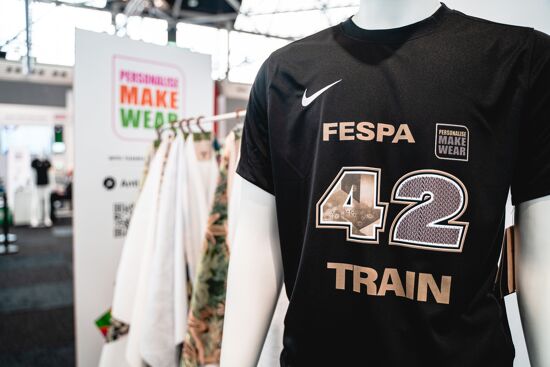Ricoh enters DTG market with two new machines
Ricoh has launched two new direct-to-garment (DTG) printers during FESPA 2017 and secured its first sale at the exhibition.
Ricoh moved into the DTG space when it acquired direct-to-garment printer manufacturer AnaJet in early 2016. The new machines are manufactured at AnaJet’s California headquarters.
The two new machines, the Ricoh Ri 3000 and Ri 6000, are based on the Anajet mPower series, but with a number of enhancements. They will be commercially available from Q3 of this year, with price yet to be set.
AnaJet international technical support specialist Marica Mody highlighted a variety of improvements on the previous AnaJet series, including an upgraded ink circulation system for white channels to improve ink flow and increase performance.
Mody said: “Screen printing, sublimation, transfer papers are huge markets that are successful, but none of them can do what DTG can do.”
The two new machines both have a printable area of 350x450mm but the Ri 3000 uses three Ricoh MH 2420 inkjet heads and the Ri 6000 uses six. In terms of speed, at 600dpi the Ri 6000 can print a 300x250mm area on a light garment in around 27 seconds, while the Ri 3000 takes 51 seconds. Both machines use AnaJet’s AnaRip software.
The machines also use AnaJet’s DTG water-based pigment inks, running CMYK plus double white. They can print on a wide variety of garment types, including t-shirts, cloth bags, hoodies, sweatshirts and socks, on materials ranging from 100% cotton and 100% light polyester to mixed garments up to 50/50 blends.
Carsten Gaarde, print shop manager of Denmark-based Jyske Bank, purchased an Ri 6000 on day 3 of FESPA 2017, which took place from 8-12 May at the Hamburg Messe. Jyske already runs five Ricoh devices, including three Ricoh Pro C9110s, in its in-house print shop.
The machine will be installed in the early autumn and will be supplied by Danish Ricoh reseller X & Co. It will mainly be used for runs of between 10 and 50 personalised t-shirts for in-house events, while Gaarde will still contract out work for longer-run t-shirt jobs.
Gaarde said: “We have a lot of different venues and this particular printer fits in in the way that if we have something in the evening we could have 10 t-shirts with names on or something."
“This is the first time I’ve seen this and the quality is way better than I’ve seen before. It’s small, easy to use, good for short runs and individual t-shirts.”
Miss any of the action from FESPA 2017? Catch up here with full show coverage.
Topics
Interested in joining our community?
Enquire today about joining your local FESPA Association or FESPA Direct
Recent news

Streamlining personalisation with tech: Insights from the SmartHub Conference 2025 speakers
Personalisation Experience 2025 (6 – 9 May 2025, Messe Berlin, Germany) is running its inaugural SmartHub Conference from 6 – 8 May 2025.

Special Effects in DTF: How Neon Inks Are Making Apparel Pop
Neon fluorescent inks are the latest innovation in DTF printing, offering vibrant, eye-catching effects under both daylight and UV light, giving apparel decorators a competitive edge. Testing shows good wash durability, though market perception of added value is still developing. With increasing adoption and ongoing technological advancements, neon represents a significant upgrade for creative customisation.

Unlocking Growth Opportunities in the Printed Personalised Apparel Industry
The printed personalised apparel industry is booming, projected to reach $10.1 billion by 2030. Driven by consumer desire for self-expression and branding needs, technological advancements like DTG/DTF and e-commerce integration are key. Sustainability, eco-friendly materials, and on-demand printing are crucial growth drivers. Businesses leveraging these trends, including AI and social media, have significant commercial potential.

Personalisation: From mass production to print-on-demand
Technological advancements are driving the growing trend of personalisation, fueled by consumer demand for unique products. From packaging campaigns like Share-a-Coke to customised apparel by Nike and Adidas, and AI-powered tools, the shift from mass production to print-on-demand is evident. The SmartHub Conference at the Personalisation Experience from 6 - 8 May will explore these opportunities and challenges for businesses.